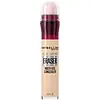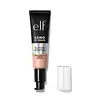Maybelline Instant Age Rewind Eraser Multi-Use Concealer Versus e.l.f. cosmetics Camo CC Cream SPF 30
What's inside
What's inside
 Key Ingredients
Key Ingredients

 Benefits
Benefits

 Concerns
Concerns

 Ingredients Side-by-side
Ingredients Side-by-side

Water
Skin ConditioningDimethicone
EmollientIsododecane
EmollientGlycerin
HumectantPEG-9 Polydimethylsiloxyethyl Dimethicone
EmulsifyingPropylene Glycol
HumectantDisteardimonium Hectorite
StabilisingSilica
AbrasiveDimethicone Crosspolymer
Emulsion StabilisingPEG-10 Dimethicone
Skin ConditioningCetyl PEG/PPG-10/1 Dimethicone
EmulsifyingPhenoxyethanol
PreservativeSodium Chloride
MaskingPolyglyceryl-4 Isostearate
EmulsifyingCaprylyl Glycol
EmollientDisodium Stearoyl Glutamate
CleansingEthylhexylglycerin
Skin ConditioningChlorphenesin
AntimicrobialAluminum Hydroxide
EmollientSteareth-20
CleansingLycium Barbarum Fruit Extract
AstringentChlorhexidine Digluconate
AntimicrobialSodium Benzoate
MaskingN-Hydroxysuccinimide
Skin ConditioningLactic Acid
BufferingPotassium Sorbate
PreservativeTocopherol
AntioxidantSodium Citrate
BufferingPalmitoyl Tripeptide-1
Skin ConditioningChrysin
Skin ConditioningPentaerythrityl Tetra-Di-T-Butyl Hydroxyhydrocinnamate
AntioxidantPalmitoyl Tetrapeptide-7
Skin ConditioningCitric Acid
BufferingBiotin
AntiseborrhoeicCI 77891
Cosmetic ColorantCI 77491
Cosmetic ColorantCI 77492
Cosmetic ColorantCI 77499
Cosmetic ColorantWater, Dimethicone, Isododecane, Glycerin, PEG-9 Polydimethylsiloxyethyl Dimethicone, Propylene Glycol, Disteardimonium Hectorite, Silica, Dimethicone Crosspolymer, PEG-10 Dimethicone, Cetyl PEG/PPG-10/1 Dimethicone, Phenoxyethanol, Sodium Chloride, Polyglyceryl-4 Isostearate, Caprylyl Glycol, Disodium Stearoyl Glutamate, Ethylhexylglycerin, Chlorphenesin, Aluminum Hydroxide, Steareth-20, Lycium Barbarum Fruit Extract, Chlorhexidine Digluconate, Sodium Benzoate, N-Hydroxysuccinimide, Lactic Acid, Potassium Sorbate, Tocopherol, Sodium Citrate, Palmitoyl Tripeptide-1, Chrysin, Pentaerythrityl Tetra-Di-T-Butyl Hydroxyhydrocinnamate, Palmitoyl Tetrapeptide-7, Citric Acid, Biotin, CI 77891, CI 77491, CI 77492, CI 77499
Ethylhexyl Methoxycinnamate 7.5%
UV AbsorberTitanium Dioxide 4.45%
Cosmetic ColorantZinc Oxide 13.72%
Cosmetic ColorantWater
Skin ConditioningDimethicone
EmollientCyclopentasiloxane
EmollientButylene Glycol
HumectantPhenyl Trimethicone
Skin ConditioningCetyl PEG/PPG-10/1 Dimethicone
EmulsifyingButylene Glycol Dicaprylate/Dicaprate
EmollientButyloctyl Salicylate
Skin ConditioningPolyglyceryl-4 Isostearate
EmulsifyingMethyl Methacrylate Crosspolymer
Cyclohexasiloxane
EmollientAcrylates/Polytrimethylsiloxymethacrylate Copolymer
Skin ConditioningHexyl Laurate
EmollientMagnesium Sulfate
Phenoxyethanol
PreservativeTriethoxycaprylylsilane
Disteardimonium Hectorite
StabilisingHydrated Silica
AbrasiveAluminum Hydroxide
EmollientPropylene Carbonate
SolventDimethicone/Methicone Copolymer
Caprylyl Glycol
EmollientEthylhexylglycerin
Skin ConditioningDisodium EDTA
Tocopheryl Acetate
AntioxidantSodium Hyaluronate
HumectantNiacinamide
SmoothingPanthenol
Skin ConditioningAscorbyl Palmitate
AntioxidantSoluble Collagen
HumectantCanola Oil
EmollientGlycerin
HumectantDaucus Carota Sativa Seed Oil
EmollientCarbomer
Emulsion StabilisingDaucus Carota Sativa Root Extract
Skin ConditioningHelianthus Annuus Seed Oil
EmollientBeta-Carotene
Skin ConditioningPolysorbate 20
EmulsifyingPalmitoyl Tripeptide-1
Skin ConditioningPalmitoyl Tetrapeptide-7
Skin Conditioning1,2-Hexanediol
Skin ConditioningCI 77891
Cosmetic ColorantCI 77492
Cosmetic ColorantCI 77491
Cosmetic ColorantCI 77499
Cosmetic ColorantEthylhexyl Methoxycinnamate 7.5%, Titanium Dioxide 4.45%, Zinc Oxide 13.72%, Water, Dimethicone, Cyclopentasiloxane, Butylene Glycol, Phenyl Trimethicone, Cetyl PEG/PPG-10/1 Dimethicone, Butylene Glycol Dicaprylate/Dicaprate, Butyloctyl Salicylate, Polyglyceryl-4 Isostearate, Methyl Methacrylate Crosspolymer, Cyclohexasiloxane, Acrylates/Polytrimethylsiloxymethacrylate Copolymer, Hexyl Laurate, Magnesium Sulfate, Phenoxyethanol, Triethoxycaprylylsilane, Disteardimonium Hectorite, Hydrated Silica, Aluminum Hydroxide, Propylene Carbonate, Dimethicone/Methicone Copolymer, Caprylyl Glycol, Ethylhexylglycerin, Disodium EDTA, Tocopheryl Acetate, Sodium Hyaluronate, Niacinamide, Panthenol, Ascorbyl Palmitate, Soluble Collagen, Canola Oil, Glycerin, Daucus Carota Sativa Seed Oil, Carbomer, Daucus Carota Sativa Root Extract, Helianthus Annuus Seed Oil, Beta-Carotene, Polysorbate 20, Palmitoyl Tripeptide-1, Palmitoyl Tetrapeptide-7, 1,2-Hexanediol, CI 77891, CI 77492, CI 77491, CI 77499
 Reviews
Reviews

Ingredients Explained
These ingredients are found in both products.
Ingredients higher up in an ingredient list are typically present in a larger amount.
Aluminum Hydroxide is a form of aluminum. It can be naturally found in nature as the mineral gibbsite. In cosmetics, Aluminum Hydroxide is used as a colorant, pH adjuster, and absorbent.
As a colorant, Aluminum Hydroxide may add opacity, or reduce the transparency. Aluminum hydroxide is contains both basic and acidic properties.
According to manufacturers, this ingredient is an emollient and humectant. This means it helps hydrate the skin.
In medicine, this ingredient is used to help relieve heartburn and help heal ulcers.
There is currently no credible scientific evidence linking aluminum hydroxide in cosmetics to increased cancer risk.
Major health organizations allow the use of aluminum hydroxide in personal care products and have not flagged it as a carcinogenic risk at typical usage levels.
Learn more about Aluminum HydroxideCaprylyl Glycol is a humectant and emollient, meaning it attracts and preserves moisture.
It is a common ingredient in many products, especially those designed to hydrate skin. The primary benefits are retaining moisture, skin softening, and promoting a healthy skin barrier.
Though Caprylyl Glycol is an alcohol derived from fatty acids, it is not the kind that can dry out skin.
This ingredient is also used as a preservative to extend the life of products. It has slight antimicrobial properties.
Learn more about Caprylyl GlycolThis ingredient is a high molecular weight silicone. It has emulsifying and skin conditioning properties.
Ci 77491 is also hydrated iron III oxide. It's sole purpose is to give a red/pink hue to products.
Iron III oxides are classified as inorganic chemicals for coloring.
Synthetically created Ci 77491 is considered safer than those naturally found. This is because the synthetically created version may contain less impurities. Iron oxides are generally non-toxic and non-allergenic.
Learn more about CI 77491Ci 77492 is also hydrated iron III oxide. It's sole purpose is to give a yellow hue to products.
Iron III oxides are classified as inorganic chemicals for coloring.
Synthetically created Ci 77492 is considered safer than those naturally found. This is because the synthetically created version may contain less impurities. Iron oxides are generally non-toxic and non-allergenic.
Learn more about CI 77492Ci 77499 is also hydrated iron III oxide. It is created from mixing red and black iron oxides. This helps give shades of darkness to a product.
Iron III oxides are classified as inorganic chemicals for coloring.
Ci 77891 is a white pigment from Titanium dioxide. It is naturally found in minerals such as rutile and ilmenite.
It's main function is to add a white color to cosmetics. It can also be mixed with other colors to create different shades.
Ci 77891 is commonly found in sunscreens due to its ability to block UV rays.
Learn more about CI 77891Dimethicone is a type of synthetic silicone created from natural materials such as quartz.
What it does:
Dimethicone comes in different viscosities:
Depending on the viscosity, dimethicone has different properties.
Ingredients lists don't always show which type is used, so we recommend reaching out to the brand if you have questions about the viscosity.
This ingredient is unlikely to cause irritation because it does not get absorbed into skin. However, people with silicone allergies should be careful about using this ingredient.
Note: Dimethicone may contribute to pilling. This is because it is not oil or water soluble, so pilling may occur when layered with products. When mixed with heavy oils in a formula, the outcome is also quite greasy.
Learn more about DimethiconeDisteardimonium Hectorite comes from the clay mineral named hectorite. It is used to add thickness to a product.
It can also help stabilize a product by helping to disperse other ingredients.
Hectorite is a rare, white clay mineral.
Learn more about Disteardimonium HectoriteEthylhexylglycerin (we can't pronounce this either) is commonly used as a preservative and skin softener. It is derived from glyceryl.
You might see Ethylhexylglycerin often paired with other preservatives such as phenoxyethanol. Ethylhexylglycerin has been found to increase the effectiveness of these other preservatives.
Glycerin is already naturally found in your skin. It helps moisturize and protect your skin.
A study from 2016 found glycerin to be more effective as a humectant than AHAs and hyaluronic acid.
As a humectant, it helps the skin stay hydrated by pulling moisture to your skin. The low molecular weight of glycerin allows it to pull moisture into the deeper layers of your skin.
Hydrated skin improves your skin barrier; Your skin barrier helps protect against irritants and bacteria.
Glycerin has also been found to have antimicrobial and antiviral properties. Due to these properties, glycerin is often used in wound and burn treatments.
In cosmetics, glycerin is usually derived from plants such as soybean or palm. However, it can also be sourced from animals, such as tallow or animal fat.
This ingredient is organic, colorless, odorless, and non-toxic.
Glycerin is the name for this ingredient in American English. British English uses Glycerol/Glycerine.
Learn more about GlycerinPalmitoyl Tetrapeptide-7 (formerly Palmitoyl Tetrapeptide-3) is a lab-made peptide with anti-inflammatory and skin-repairing benefits. It's made up of four amino acids (glycine, glutamine, proline, and arginine) and palmitic acid (which helps it penetrate skin more effectively).
This ingredient helps reduce inflammation by limiting the production of interleukin-6 (IL-6), a chemical that triggers inflammatory responses, particularly after UV exposure.
Less inflammation = slower collagen breakdown and a longer-lasting, youthful appearance.
Palmitoyl Tetrapeptide-7 also stimulates collagen production and supports a healthier skin barrier.
Over time, this can improve skin firmness, hydration, and reduce the appearance of fine lines. It’s commonly paired with Palmitoyl Tripeptide-1 in the well-known Matrixyl 3000 complex for enhanced anti-aging effects.
This ingredient has been shown to be effective and safe in cosmetic use and you'll typically find it in small amounts (less than 0.01%).
Due to its palmitic acid base, it may not be safe for Malassezia folliculitis.
Read more about other common types of peptides here:
Learn more about Palmitoyl Tetrapeptide-7Palmitoyl Tripeptide-1 is also known as pal-GHK. It is made up of 3 amino acids and palmitic acid, a fatty acid that helps it absorb into skin more easily.
This peptide is as a signal peptide, meaning it tells the skin to produce more collagen. Collagen is the key protein that helps form the skin's structure and keep it plump, firm, and hydrated.
By boosting collagen production, this ingredient supports a stronger skin barrier and helps reduce the appearance of wrinkles.
You'll most likely see this ingredient paired with Palmitoyl Tetrapeptide-7 in the well-known Matrixyl 3000 complex. While results from in-house testing should be viewed cautiously, this peptide duo is among the most studied and widely used in modern skincare.
Due to its palmitic acid base, this ingredient may not be safe for Malassezia folliculitis.
Read more about other common types of peptides here:
Learn more about Palmitoyl Tripeptide-1Phenoxyethanol is a preservative that has germicide, antimicrobial, and aromatic properties. Studies show that phenoxyethanol can prevent microbial growth. By itself, it has a scent that is similar to that of a rose.
It's often used in formulations along with Caprylyl Glycol to preserve the shelf life of products.
This ingredient is an emulsifer and stabilizer. It comes from isostearic acid and polyglycerin.
As an emulsifier, it helps blend oil and water to improve texture, spreadbility, and application.
Due to it being derived from isostearic acid, this ingredient may not be fungal acne safe.
Learn more about Polyglyceryl-4 IsostearateWater. It's the most common cosmetic ingredient of all. You'll usually see it at the top of ingredient lists, meaning that it makes up the largest part of the product.
So why is it so popular? Water most often acts as a solvent - this means that it helps dissolve other ingredients into the formulation.
You'll also recognize water as that liquid we all need to stay alive. If you see this, drink a glass of water. Stay hydrated!
Learn more about Water